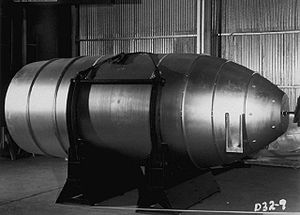Mark 14 nuclear bomb
| Mark 14 nuclear bomb | |
|---|---|
 A photo of a Mk14 without tail section attached | |
| Type | Thermonuclear gravity bomb |
| Place of origin | United States |
| Service history | |
| In service | 1954-1956 |
| Wars | Cold War |
| Production history | |
| Designer | Los Alamos National Laboratory |
| Designed | 1954 |
| Produced | Feb-Oct 1954[1] |
| No. built | 5 |
| Specifications | |
| Mass | 28,950–31,000 lb (13,130–14,060 kg) |
| Length | 222 in (5.6 m) |
| Diameter | 61.4 in (156 cm) |
Detonation mechanism | Air burst |
| Blast yield | 5–7 megatonnes of TNT (21–29 PJ) (deployed Mk-14) 6.9 megatonnes of TNT (29 PJ) (Castle Union test device) |


The Mark 14 nuclear bomb was a 1950s
Sloika
in the Soviet Union.
The fusion fuel used by the bomb was 95% enriched Lithium
nuclear fusion reactions as isotope 6. The Mk-14 bomb had a diameter of 61.4 inches (1.56 m) and a length of 222 inches (5.64 m). They weighed between 28,950 and 31,000 pounds (13,100 and 14,100 kg), and used a 64 feet (20 m) parachute.[1]
The version tested at Castle Union used a RACER IV primary. 5 Mt of its total yield came from fission, making it a very "dirty" weapon.[2]
By 1956, the components of all five of the produced Mk-14 bombs had been recycled into Mark 17s.
See also
Notes
- ^ a b "List of All U.S. Nuclear Weapons". The Nuclear Weapon Archive. 30 March 2023. Retrieved 10 Aug 2023.
- ^ "Operation Castle". The Nuclear Weapon Archive. 17 May 2006. Retrieved 10 Aug 2023.
References
- Hansen, Chuck, "Swords of Armageddon: U.S. Nuclear Weapons Development since 1945" (CD-ROM & download available). PDF-2.67 Mb. 2,600 pages, Sunnyvale, California, Chucklea Publications, 1995, 2007. ISBN 978-0-9791915-0-3(2nd Ed.)
